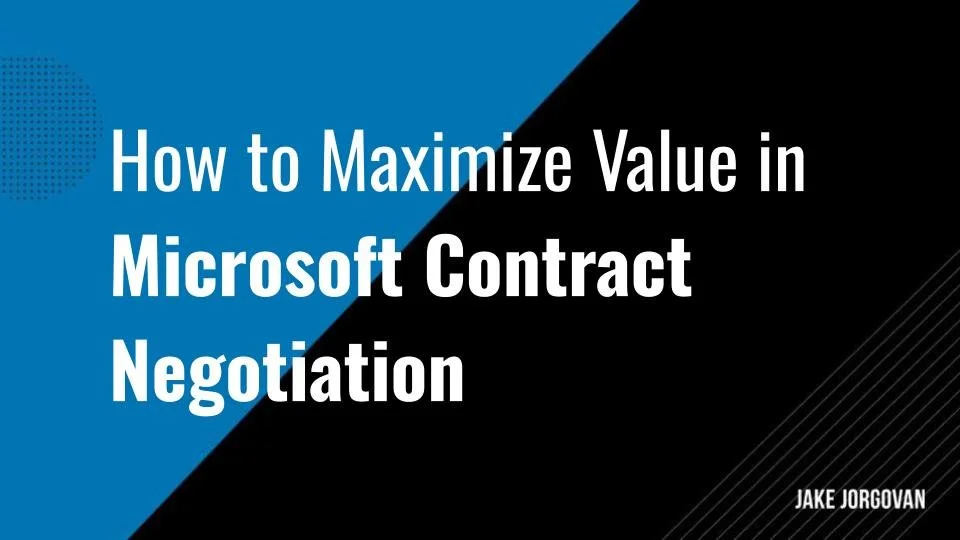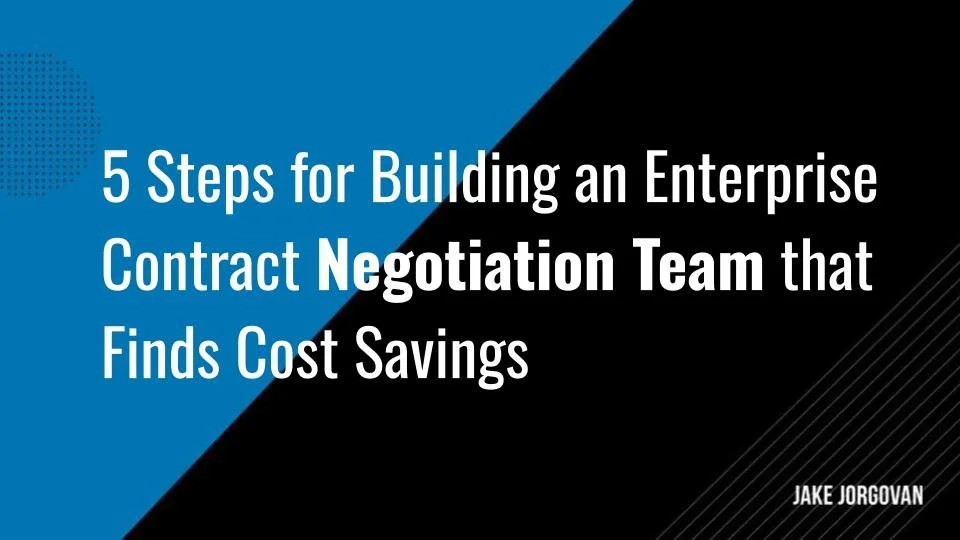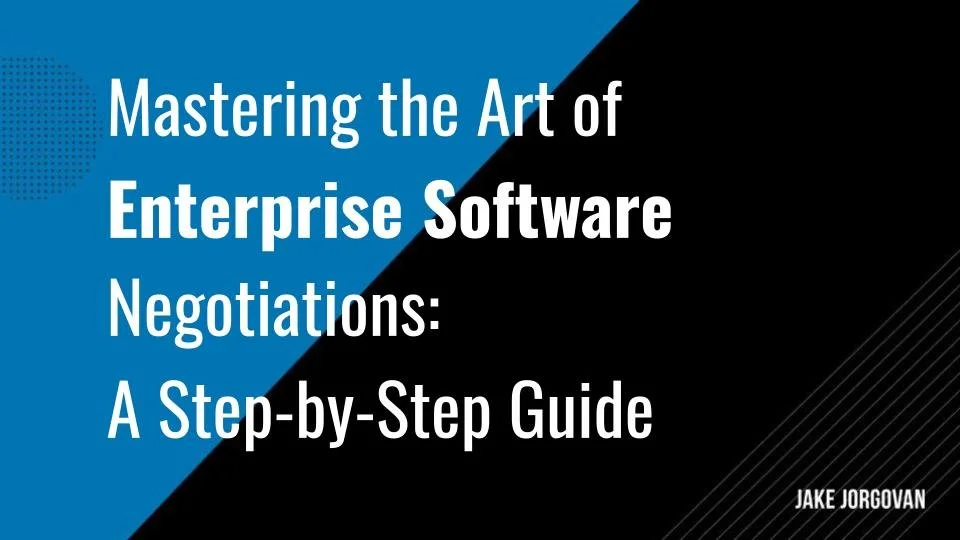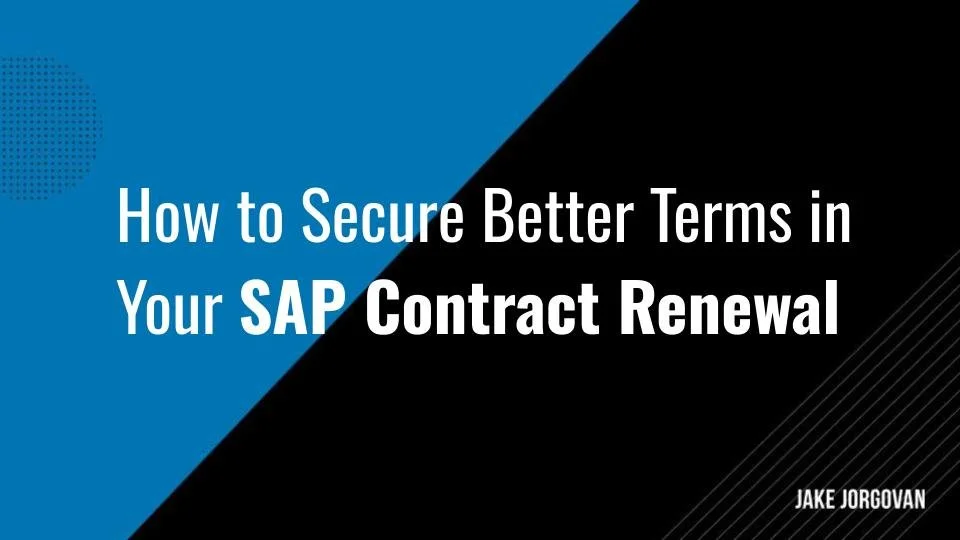7 Essential Tips for Negotiating a Salesforce Contract: What Every Business Should Know
Negotiating a Salesforce contract isn’t just about getting a good price. It’s about securing the right features and terms that align with your business goals so you can get the most out of your software for a long time to come.
You need to ensure flexible terms, scalability, and clear cost breakdowns. Each detail in the contract impacts your ability to leverage Salesforce effectively. Understanding the nuances of Salesforce's pricing and service agreements allows you to avoid common pitfalls and maximize your investment.
In this article, we’ll walk you through 7 must-know tips for negotiating a Salesforce contract with a high level of confidence so you get the best possible deal for your money.
Essential Tips for Negotiating a Salesforce Contract
Negotiating a Salesforce contract can be complex, but careful preparation ensures you get the most value for your investment. With the strategies discussed below, you can minimize hidden fees, clarify terms, and establish a partnership that supports your business goals.
1) Understand Your Specific Needs Before Engaging
Before you start the contract negotiation process, you first need to get a clear and complete picture of where you are right now and what you want to get out of the contract. This will help you negotiate more confidently and make decisions more easily. Here’s how to define your needs:
Start by identifying your business objectives. Be clear about what you need Salesforce to achieve. Below, you can see some common benefits of Salesforce — find out how these can apply to your goals.
Map out your current processes, and find out where Salesforce fits in.
List the specific features and integrations you need. Prioritize what's essential, not just nice-to-have.
Consider your team's capabilities and make sure Salesforce aligns with their skills and responsibilities.
Analyze your budget constraints and get clear on how much you're willing to invest. Some research suggests that the average cost of a Salesforce implementation ranges from $10,000 to over $200,000, depending on factors like customization and integration needs.
Prioritize your needs — decide which elements are non-negotiable and, if any, areas where you might be prepared to compromise.
Consult with key stakeholders to make sure everyone agrees on the priorities.
Revisit your initial list. Make adjustments based on feedback.
Carefully document your final requirements — this will be your reference point in negotiations.
Enter the engagement with a clear, defined scope. This clarity will guide your discussions.
We always advise our clients to request a sandbox environment from Salesforce before finalizing the contract. This allows you to test key features and integrations in a controlled setting so you can identify potential issues early and negotiate necessary adjustments before committing to a full implementation.
This practical step ensures you only pay for what truly meets your needs.
2) Research Salesforce's Pricing Structures
Salesforce’s pricing structures can be pretty confusing, and if you aren’t familiar with how they work and what to expect it’s easy to end up with the wrong deal for you. Here’s how to avoid that:
Go to Salesforce’s official pricing page and review the tiers and options offered.
Identify the plans relevant to your business size and needs. Don’t get distracted by unnecessary features, focus on the things you need.
Break down each plan. Focus on user limits, included features, and available add-ons.
Compare these options with your budget, and make sure you understand the total cost implications.
Reach out to Salesforce directly. Request a detailed quote based on your specific requirements and actual usage.
Consider hidden costs. These could include potential overages, customization fees, and future scaling.
Seek out reviews and experiences from other companies in your industry who have negotiated similar contracts.
Analyze competitor offerings. Understand how Salesforce's pricing compares to alternative solutions.
Document your findings. This research can help you secure better terms during negotiations.
Approach the pricing discussion with a well-informed strategy. Being prepared will help you get the best possible deal.
Salesforce's pricing structures are complex and vary significantly depending on the products and features you select. For example, the Salesforce Sales Cloud offers multiple pricing tiers, ranging from Starter Suite at $25 per user per month to Unlimited at $330 per user per month. You can see more in the image below:
Each tier adds more features, such as advanced automation tools, API integration, and 24/7 support. Additionally, other products like Marketing Cloud Personalization can cost enormous sums of money.
Understanding these different structures helps you align your budget with your specific business goals and invest in the right features without overspending.
3) Leverage Competitive Quotes for Better Terms
Negotiating is always easier from a position of strength. By arming yourself with favorable quotes from Salesforce’s competitors, you can give yourself an advantage and possibly secure better terms. Here’s how:
Start by researching alternative Customer Relationship Management (CRM) software providers. Identify those with similar features to Salesforce.
Request detailed quotes from these providers based on the same or comparable features you need from Salesforce.
Document the pricing and features of each option. Include any special offers or discounts.
Compare the differences between Salesforce and its competitors. Focus on cost, features, and support levels.
For example, Microsoft Dynamics 365 offers CRM solutions starting at $70 per user per month.
Zoho CRM provides plans beginning at $14 per user per month, with a free plan available for up to three users.
Freshsales CRM offers a free plan and paid plans starting at $15 per user per month when billed annually.
Present these competitive quotes to your Salesforce representative and highlight any significant cost savings or added value from competitors.
Use this data to negotiate for better pricing or additional features in your Salesforce contract.
Maintain a firm but open stance. Make it clear you are prepared to switch providers if necessary.
Leveraging competitive quotes in this way allows you to gain bargaining power. This approach can often lead to better terms and lower annual costs in your final Salesforce agreement.
Insider tip: We recommend documenting every interaction with Salesforce during your negotiations. Keep detailed notes of verbal agreements, promises, and potential concessions your Salesforce representative offers. This creates a clear record you can refer back to if there’s any discrepancy in the final contract. If something is promised but not reflected in writing, you have solid grounds to request its inclusion.
4) Prioritize Key Features that Align with Your Goals
Salesforce has a ton of comprehensive features, like those mentioned in the image below.
You most likely don’t need every single Salesforce feature, and it doesn’t make sense to pay for what you don’t use. If you prioritize the features that are most important for your goals, you can get a more cost-effective annual contract. Here’s how to begin:
Start by defining your business objectives and what you need to achieve with Salesforce.
Review all available features in Salesforce and hone in on those that directly support your objectives. Interestingly, about 43% of CRM users use less than half of the available features in their CRM systems. For example, tools like Einstein Activity Capture (EAC) can automatically sync emails and calendar events with Salesforce, which can be invaluable if your team relies heavily on accurate activity tracking.
Create a list of essential features. These are non-negotiable and must align with your goals.
Identify secondary features that are useful but not critical. Only consider them if your budget allows it.
Rank the features based on their impact on your business, and prioritize those that offer the most value.
Discuss these priorities with your team so everyone agrees on what features matter most.
Use this prioritized list to guide your negotiations. Focus on securing the key features first.
For example, if you’re a highly data-driven company, a non-negotiable feature for you might be custom dashboards. Salesforce allows you to build highly customizable dashboards that can display real-time data across various performance metrics. These dashboards allow you to monitor key performance indicators (KPIs) and make data-driven decisions quickly.
5) Negotiate Contract Flexibility and Scalability
Your business is likely to change — and hopefully grow — over the course of your Salesforce contract. This means the terms you secure today might no longer be ideal in a year or two.
It’s important to factor in your business’s future trajectory and allow for flexibility and scalability in your contract by doing the following:
Carefully assess your business's growth potential and how your needs might change over the next few years.
Request contract terms that allow for easy scaling. For example, make sure you can add or reduce users without significant penalties.
Negotiate flexible pricing tiers. These should align with your expected growth and make it easy to adjust without renegotiating the entire contract. Securing flexible contract terms in Salesforce negotiations allows your business to adapt to changes, ensuring you can scale services up or down as needed without incurring unnecessary costs.
Ask for options to upgrade or downgrade features. You should be able to make these changes without disrupting your operations.
Review the contract carefully. Confirm that any flexibility or scalability terms are clearly documented and enforceable.
Insider tip: We always advise our clients to include a “growth clause” in their Salesforce contracts. This clause allows you to lock in pricing for additional licenses or features at your initial rate for a specified period. It prevents unexpected cost increases as your business scales, which is especially useful if you anticipate significant growth.
Securing this clause helps you maintain budget predictability and protect your bottom line as you expand.
6) Secure Detailed Service-Level Agreements
Service level agreements (SLAs) are a way of insuring yourself against any potential problems you might run into with Salesforce. Here’s an example of what an SLA might look like:
An SLA helps you document your expectations from the contractual relationship and protects you if your provider fails to deliver what they promised.
Here’s how to get the most out of an SLA:
First, identify the specific services you expect from Salesforce. This includes uptime, response times, and support levels.
Request a draft of the service level agreement (SLA) from Salesforce. Review it carefully for any gaps.
Make sure the SLA clearly defines uptime guarantees — look for at least 99.9% uptime to minimize disruption. Salesforce typically guarantees an uptime of 99.9%, which translates to about 43 minutes of downtime per month or approximately 8 hours and 45 minutes per year.
Confirm response time commitments. Specify how quickly Salesforce must address and resolve issues, especially for critical systems.
Negotiate penalties for non-compliance. These could include service credits or other compensation if Salesforce fails to meet the agreed standards.
Review the support levels included to make sure they align with your needs and cover both standard and emergency support.
Document all agreed terms in the final SLA. This must be a legally binding part of your contract.
Securing detailed SLAs helps protect your business from service interruptions and ensures accountability, which is crucial for keeping your operations running.
7) Ensure Transparency in Cost Breakdowns
With any contract, you should always know exactly what you are paying for and what services you are getting. Salesforce will provide comprehensive cost breakdowns, but it’s up to you to make sure you get all the information you need for a complete picture. Here’s how to do it:
Request a detailed cost breakdown from Salesforce. This should include all components: licensing fees, add-ons, support, and any additional charges. For instance, Salesforce's Premier Success Plan costs an additional 30% of your license fee.
Review each line item carefully. Does each cost directly correspond to a specific service or feature you require?
Ask for clarification on any ambiguous charges. You need to make sure there are no hidden fees or unexpected costs.
Compare the breakdown with your contract. Confirm that the costs line up with what was agreed upon during negotiations.
Insist on transparency in future billing. Request regular, itemized invoices to stay on top of ongoing costs.
If there are any discrepancies, clearly document them and address them promptly with your Salesforce representative to avoid future issues.
Insider tip: We always recommend pushing for a "cost alignment clause" during contract negotiations. This ties your payment structure directly to the performance and usage of specific features, so if a feature underperforms or isn’t used as anticipated, you have the leverage to adjust your costs accordingly.
Common Mistakes When Negotiating a Salesforce Contract
Negotiating Salesforce contracts can be challenging, and mistakes are common. In fact, we wrote an entire article on this topic here.
Here are the main takeaways:
Overlooking hidden costs and fees: Failing to identify hidden fees in Salesforce contracts can lead to unexpected financial strain. It's essential to review the contract line by line, identify all fees, question ambiguous costs, compare with industry standards, and negotiate unnecessary charges.
Failing to secure flexible contract terms: Inflexible contract terms can hinder your ability to adapt to changing business needs. Make sure your contract allows for adjustments in services, features, and payment terms to accommodate growth and unforeseen demands.
Underestimating renewal and escalation clauses: Overlooking contract renewal and escalation clauses can result in automatic price increases or unfavorable changes in terms. Scrutinize these clauses, negotiate limits on price hikes, and get clarity on renewal terms and renewal dates to protect your financial interests.
Neglecting to define clear service level agreements (SLAs): Without clear SLAs, you may face service interruptions without recourse. Define specific expectations for service performance, response times, and support levels to ensure accountability and protect your operations.
By being aware of these common pitfalls and taking proactive steps to address them, you can negotiate a Salesforce contract that aligns with your desired business outcomes and safeguards your interests.
Negotiate with Confidence
Negotiating a Salesforce contract demands precision and strategic foresight.
You need to understand your specific needs and future requirements so you can ensure the contract reflects them. Tap into competitive quotes to gain better terms, prioritize key features that line up with your business goals, and insist on detailed service-level agreements.
Each step in this article is crucial when it comes to securing a deal that supports your growth without unexpected costs. By following this guide, you’ll maximize the value of your Salesforce partnership while avoiding potential pitfalls and unwanted financial consequences.
Frequently Asked Questions
What are the key steps in negotiating a Salesforce agreement?
Define your business needs, prioritize essential features, request a detailed breakdown of your annual license cost, and use competitive quotes to negotiate better pricing and terms. Make sure all agreements, including flexibility and SLAs, are documented in the contract.
How do you negotiate a service-level agreement?
Clearly define uptime guarantees, response times, and support levels while negotiating penalties for non-compliance. Review the SLA carefully to ensure all terms are enforceable and aligned with your business needs.
How do you negotiate a contract clause?
Identify the specific clause to modify, propose clear and reasonable changes, and provide a justification based on your business requirements or risks. Work collaboratively with Salesforce to reach an agreement that benefits both parties.
How do you ask for a lower price with Salesforce?
Present detailed cost comparisons from alternative providers and highlight any redundant or underused features in the proposal. Emphasize your willingness to commit to a long-term agreement or bundle additional services in exchange for a lower rate.
How do you ask for a Salesforce discount professionally?
Approach your Salesforce representative with a clear business case, citing your usage patterns, growth potential, and budget constraints. Request a customized pricing plan that reflects your specific needs while showcasing your commitment to maximizing the partnership.






























